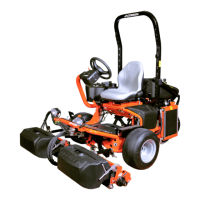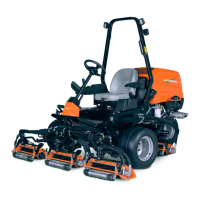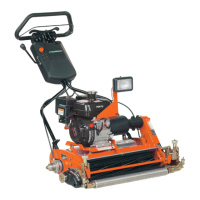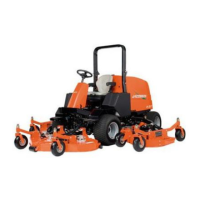5-56 4252490-Rev A
HYDROSTATIC POWER TRAIN
5
6. Disconnect hoses (4 and 5) from flushing valve
assembly (6).
7. Support flushing valve assembly (6).
8. Remove three mounting screws (3).
9. Remove flushing valve assembly (6).
Installation Notes
• Install flushing valve by reversing the order of
removal.
• Lubricate all O-rings prior to assembly.
• Make sure new O-rings are in place before installing
hoses on fittings.
• Replace hydraulic oil charge filter. (See “Hydraulic
Oil Charge Filter Assembly” on page 6-59.)
• Refill hydraulic oil tank. (Refer to “Parts and
Maintenance Manual” for correct oil specifications.)
• Start engine. Check hydraulic system for leaks.
Repair as necessary.
• Check hydraulic oil level and add if necessary.
Disassembly, Inspection, and Assembly
See Figure 5-56.
Figure 5-56
1. Remove two nuts (8), washers (7), washers (11), and
screws (1), and remove flushing valve (3).
NOTE
Record the location of fittings before removing to ensure
correct installation.
2. Remove, inspect, and replace fittings (2) for ports
“RW1” and “RW2” as necessary.
3. Remove, inspect, and replace fitting (5) for port “DR”
as necessary.
4. Remove, inspect, and replace fitting (9) for port “PP”
as necessary
5. Clean all parts using clean solvent, and dry using
compressed air.
6. Inspect all parts for wear or damage. Replace as
necessary.
Assembly Notes
NOTICE
• Assemble the flushing valve by reversing the order of
disassembly.
• Use a new seal kit during assembly.
• Lubricate all O-rings prior to assembly.
• Tighten relief valve (4) to 44 lb-ft (60 N·m).
• Tighten check valve (10) to 44 lb-ft (60 N·m).
• Tighten fittings (2) for ports “RW1” and “RW2” to
77 lb-ft (105 N·m).
• Tighten fitting (5) for port “DR” to 27 lb-ft (37 N·m).
• Tighten fitting (9) for port “PP” to 27 lb-ft (37 N·m).
TN3916
1
2
11
5
6
9
7
8
3
4
10
It is important that all component parts are
absolutely clean, as contamination can result in
serious damage and/or improper operation.
Never use shop towels or rags to dry parts after
cleaning, as lint may clog passages. Dry parts
using compressed air.
Required Materials
•Seal Kit

